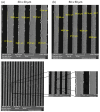Plasma-Activated Polydimethylsiloxane Microstructured Pattern with Collagen for Improved Myoblast Cell Guidance
- PMID: 38474025
- PMCID: PMC10932060
- DOI: 10.3390/ijms25052779
Plasma-Activated Polydimethylsiloxane Microstructured Pattern with Collagen for Improved Myoblast Cell Guidance
Abstract
We focused on polydimethylsiloxane (PDMS) as a substrate for replication, micropatterning, and construction of biologically active surfaces. The novelty of this study is based on the combination of the argon plasma exposure of a micropatterned PDMS scaffold, where the plasma served as a strong tool for subsequent grafting of collagen coatings and their application as cell growth scaffolds, where the standard was significantly exceeded. As part of the scaffold design, templates with a patterned microstructure of different dimensions (50 × 50, 50 × 20, and 30 × 30 μm2) were created by photolithography followed by pattern replication on a PDMS polymer substrate. Subsequently, the prepared microstructured PDMS replicas were coated with a type I collagen layer. The sample preparation was followed by the characterization of material surface properties using various analytical techniques, including scanning electron microscopy (SEM), energy-dispersive X-ray spectroscopy (EDS), and X-ray photoelectron spectroscopy (XPS). To evaluate the biocompatibility of the produced samples, we conducted studies on the interactions between selected polymer replicas and micro- and nanostructures and mammalian cells. Specifically, we utilized mouse myoblasts (C2C12), and our results demonstrate that we achieved excellent cell alignment in conjunction with the development of a cytocompatible surface. Consequently, the outcomes of this research contribute to an enhanced comprehension of surface properties and interactions between structured polymers and mammalian cells. The use of periodic microstructures has the potential to advance the creation of novel materials and scaffolds in tissue engineering. These materials exhibit exceptional biocompatibility and possess the capacity to promote cell adhesion and growth.
Keywords: PDMS; coating; collagen type I; cytocompatibility; microstructure; myoblast cell; nanostructured pattern; replication; soft lithography.
Conflict of interest statement
The authors declare no conflicts of interest.
Figures







References
-
- Rajendran A.K., Kim H.D., Kim J.-W., Bae J.W., Hwang N.S. Nanotechnology in tissue engineering and regenerative medicine. Korean J. Chem. Eng. 2023;40:286–301. doi: 10.1007/s11814-022-1363-1. - DOI
-
- Kirkpatrick C.J., Mittermayer C. Theoretical and practical aspects of testing potential biomaterials in vitro. J. Mater. Sci. Mater. Med. 1990;1:9–13. doi: 10.1007/BF00705347. - DOI
-
- De Jong W.H., Carraway J.W., Geertsma R.E. Chapter 6—In vivo and in vitro testing for the biological safety evaluation of biomaterials and medical devices. In: Boutrand J.P., editor. Biocompatibility and Performance of Medical Devices. 2nd ed. Woodhead Publishing; Sawston, UK: 2020. pp. 123–166.
MeSH terms
Substances
LinkOut - more resources
Full Text Sources
Research Materials

